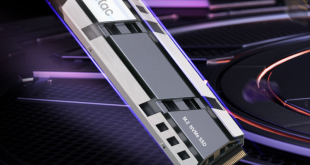Sapphire are using their QBIOS interface, which is an American Megatrends implementation. I like the lower section of this interface as it gives a real time view of temperatures, voltages and speeds.
The ‘Performance' tab gives access to the CPU, Memory and Voltage panels for overclocking. We will look at this shortly.
The ‘Advanced' Tab allows the user control over the various aspects of the hardware, including monitoring temperatures and voltages.
The ‘Chipset' tab details the onboard graphics capabilities, when partnered up with a suitable processor.
The ‘Boot' tab allows control over the onboard drive priority and status.
The ‘Security' tab can be used to protect the settings, if the system is to be used in a social environment. The ‘Exit' tab can be used to ‘load' and ‘save' configurations. This panel also includes the S_BIOS which allows the user to update and back up the BIOS from within the BIOS – there is no need to boot from an external disk.
The ‘Performance' tab gives an overview of the installed processor. In this case the latest Core i7 3770k. Unlike the ASUS boards we tested recently which configure the Core i7 3770k to a ratio limit of 39 in all states (3900mhz), the Sapphire board defaults to 39 with 1 or 2 cores active, dropping to 38 with 3 cores active, and 37 when all four cores are active. We can override this, but for the purposes of testing, we need to leave this at the default state.
We had some problems with high speed memory and could not get 2,400mhz ram from Corsair, G.Skill or Kingston to run at the native speeds. Even G.Skill 2133mhz memory which we had at hand wouldn't run above 1,600mhz. We have experienced similar concerns with previous Sapphire boards, although they normally update the bios a few weeks after launch with fixes for memory support.
Sapphire may mention limited speeds (up to 1600mhz) in their literature for the product, however the bios seems to cater to the fastest memory available today, right up to 2666mhz. Sadly we were unable to get a post with memory faster than 1,600mhz.
We ended up using the ultra compatible AMD Performance Edition Memory, which we reviewed here.
Above, 8GB of Kingston 2,400mhz memory installed. The XMP Profile detects the correct speeds and timings, however the system fails to post, heading automatically into recovery mode on third post.
We already know that this Core i7 3770k sample can run at 4.6ghz @ 1.25 volts. Thankfully this latest bios from Sapphire includes the option to directly select core voltage, as shown above. Previously we were forced to deal with the tricky ‘offset mode'.
We configured the Ratio to 46/46/46/46 in all states, which translates into a 4.6ghz final clock speed.
Above, we ensured that CPU loadline was configured to 100%.
Overclocking the board was simple enough and we achieved stability at 4.6ghz without much effort. One thing we need to point out however is that the board will slightly under volt the processor.
We show an example above, when we configured the system at 1.37 volts (above left) and the actual voltage to the processor was 1.33 volts. We know that stability at 4.8ghz would be flaky, so we manually increased this to 1.39. This translated to a real figure around 1.36 volts. If you buy this board and overclock, this is worth bearing in mind.
We managed to push the Core i7 3770k to 4.8ghz, although it required 1.35 volts. In the real world this means the user will need at least a Corsair H100 all in one liquid cooler for long term 24/7 operation. We backed down by 200mhz to 4.6ghz (requiring 1.25 volts) and we had a nicely overclocked, cool running system.
These results are identical to the ASUS and ASRock Z77 motherboards we reviewed earlier this week and is a great achievement for Sapphire. If they can update the bios soon to fix high speed memory support, we have no concerns in recommending this board to the demanding overclocking enthusiast.
Default validation is available here.
Validation at 4.6ghz is available here.
 KitGuru KitGuru.net – Tech News | Hardware News | Hardware Reviews | IOS | Mobile | Gaming | Graphics Cards
KitGuru KitGuru.net – Tech News | Hardware News | Hardware Reviews | IOS | Mobile | Gaming | Graphics Cards





















Nice review thank you. Seems their bioses are getting better when overclocking by the layout. Didnt know they nicked EVGA engineers !
I think they make good products, but and its a big but. their allegance with AMD rules out SLI and this puts a lot of people off. Its a major hurdle for them.
The first bios they released was dire, I remember it. this is a big step up. Still some way to go before they reach ASUS level, DIGI POWER+ menu alone is incredible and they have dedicated controls for vdroop etc.